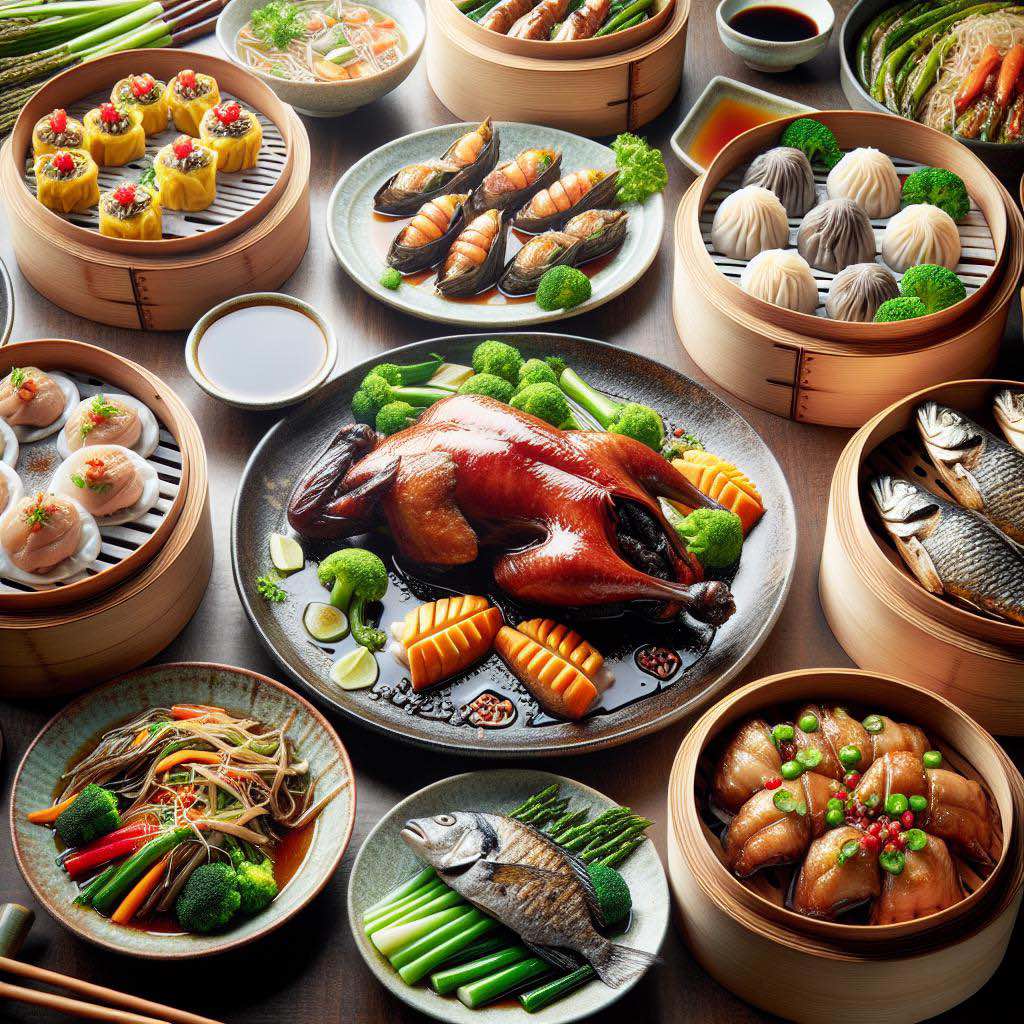
Introduction to Cantonese Cuisine
Cantonese cuisine, originating from the Guangdong province in southern China, is known for its emphasis on fresh ingredients, subtle flavors, and refined cooking techniques. Unlike the fiery heat of Sichuan dishes, Cantonese cooking focuses on highlighting the natural taste of ingredients through gentle seasoning and careful preparation. This makes it one of the most beloved and widely appreciated Chinese regional cuisines around the world.
Cantonese chefs are known for their mastery of balancing flavors—keeping them light and fresh while allowing the ingredients to shine. It’s a cuisine that embraces sweetness, umami, and mild savory profiles without overwhelming the palate.
Key Ingredients in Cantonese Cuisine
Cantonese cuisine uses a variety of fresh and high-quality ingredients, often seasoned with simple sauces and aromatics to let their natural flavors take center stage:
- Soy Sauce: A key seasoning used in both light and dark varieties.
- Oyster Sauce: Adds a rich, umami flavor to many Cantonese stir-fries.
- Rice Wine: Used for marinating meats and in cooking, providing a fragrant, slightly sweet note.
- Ginger & Scallions: Essential aromatics that bring freshness to many dishes.
- Dried Seafood: Items like dried shrimp or scallops add a concentrated umami flavor to soups and stir-fries.
- Chinese Barbecue (Char Siu): A sweet and savory roasted pork, marinated in a sauce of soy, honey, and five-spice powder, served as a popular street food and restaurant favorite.
Popular Cantonese Dishes
Cantonese cuisine offers a wide variety of dishes, from delicate dim sum to rich roasted meats. Here are some of the must-try recipes from this region:
1. Dim Sum (点心)
A hallmark of Cantonese cuisine, dim sum includes bite-sized dishes like steamed dumplings, buns, and rolls, often served with tea. Favorites include har gow (shrimp dumplings) and char siu bao (barbecue pork buns).
2. Char Siu (叉烧)
Char Siu, or Cantonese barbecue pork, is known for its sweet and savory glaze. Marinated in a mixture of soy sauce, honey, and five-spice powder, the pork is roasted to perfection, resulting in a dish with a tender interior and caramelized exterior.
3. Cantonese Steamed Fish (清蒸鱼)
A classic, light dish that showcases the Cantonese focus on fresh ingredients. Whole fish, often sea bass or grouper, is steamed with soy sauce, ginger, and scallions, allowing the natural flavor of the fish to shine.
4. Wonton Noodle Soup (云吞面)
A comforting bowl of wonton noodle soup features delicate pork and shrimp wontons floating in a fragrant broth with thin, springy noodles. The dish is light yet satisfying, with a focus on the clarity of flavors.
5. Roast Duck (烧鸭)
Cantonese roast duck is a flavorful dish where the duck is marinated and roasted until the skin is crispy and golden, while the meat stays tender and juicy. It’s often served with hoisin sauce and steamed buns.
Cooking Techniques in Cantonese Cuisine
Cantonese cooking relies on a range of techniques that emphasize precision and balance, allowing the natural flavors of ingredients to take center stage:
- Stir-frying (Chao): Quick and high-heat cooking used to preserve the color and texture of ingredients.
- Steaming (Zheng): A method that retains the purity of flavors, often used for fish, vegetables, and dim sum.
- Roasting (Kao): A technique for meats like duck and pork that develops rich flavors and textures.
- Poaching (Shui Zhu): A gentle technique used for delicate ingredients like chicken, often accompanied by ginger and scallions.
The Art of Dim Sum
No exploration of Cantonese cuisine is complete without discussing Dim Sum. Dim sum, meaning “touch the heart,” is a dining experience that involves sharing a variety of small dishes, often served in bamboo steamers, with tea. The tradition originates from Cantonese teahouses and includes a wide range of flavors and textures. Popular dim sum dishes include:
- Har Gow (Shrimp Dumplings): Delicate, translucent dumplings filled with fresh shrimp.
- Shumai (Pork and Shrimp Dumplings): Open-topped dumplings filled with seasoned pork and shrimp.
- Egg Tarts (蛋挞): A sweet and flaky pastry filled with a creamy egg custard, served warm.
- Rice Noodle Rolls (肠粉): Soft rice noodles filled with shrimp, pork, or beef and served with a sweet soy sauce.
Dim sum is typically enjoyed in the morning or early afternoon, often as a leisurely meal with family and friends.
Pairing Cantonese Cuisine with Drinks
Cantonese cuisine pairs well with drinks that complement its subtle flavors and bring balance to the meal:
- Chinese Tea (Pu-erh, Jasmine, Oolong): A perfect pairing for dim sum, tea enhances the flavors of delicate dishes and aids digestion.
- Rice Wine: A mildly sweet and fragrant drink that works well with roasted meats and seafood.
- Light Beer: A crisp, refreshing choice to balance the richness of roasted meats and savory dishes.
Cantonese cuisine offers a delicate and flavorful contrast to the bold, spicy dishes of other Chinese regions. Its emphasis on fresh ingredients and precise cooking techniques makes it a favorite among food lovers worldwide. Whether you’re enjoying a plate of Char Siu or sharing Dim Sum with friends, Cantonese food brings warmth and comfort to the table.
Ready to explore the flavors of Cantonese cooking? Check out our Cantonese recipes and start creating these delicious dishes at home!